Panasonic Leica DG Vario-Elmar 100-400 mm f/4.0-6.3 ASPH. POWER O.I.S.
3. Build quality and image stabilization
As you can notice, compared to the Panasonic 100-300 mm and the Olympus 75-300 mm you deal here with a device which is bigger, heavier and more solid. Still when you stack it up against 100-400 mm class models designed for bigger sensors it looks almost diminutive and very handy. Just look at the photo below where we positioned the tested lens between the Fujinon XF 100–400 mm f/4.5–5.6 R LM OIS and the kit Panasonic 14–42 mm.
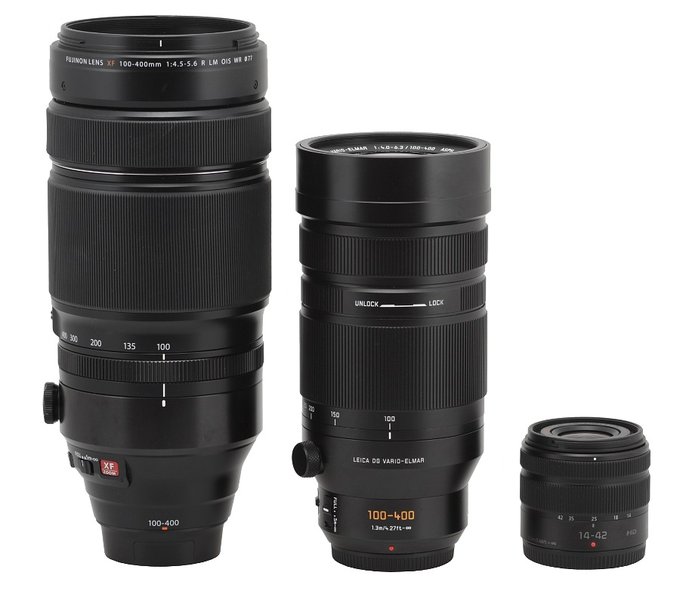 |
Please Support UsIf you enjoy our reviews and articles, and you want us to continue our work please, support our website by donating through PayPal. The funds are going to be used for paying our editorial team, renting servers, and equipping our testing studio; only that way we will be able to continue providing you interesting content for free. |
- - - - - - - - - - - - - - - - - - - - - - - - - - - - - - - - - - - - - - - - - - - - - - - -
The Panasonic Leica DG Vario-Elmar 100–400 mm f/4.0–6.3 ASPH. POWER O.I.S. starts with a metal mount which surrounds contacts and a rear element of the lens, 19 mm in diameter. That element moves and it is situated on the same level as the contacts at 100 mm; when you pass to 400 mm it hides about 3.5 cm deep inside an inner tube. The interior of that tube, revealed by that movement, is very nicely blackened and matted.
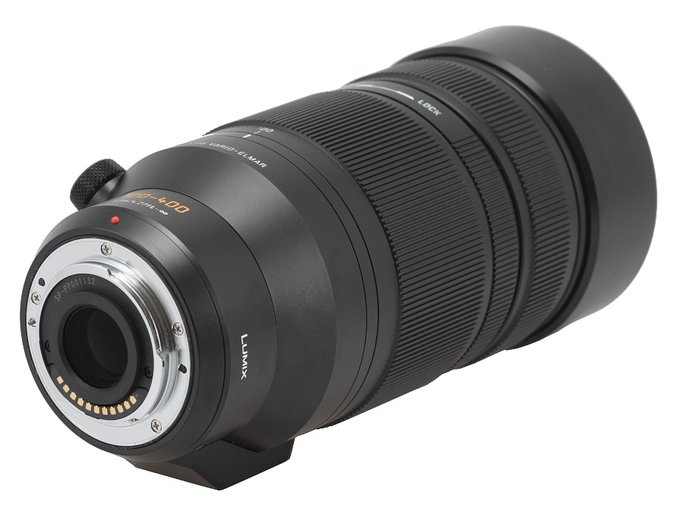 |
The proper body of the lens starts with a black, metal ring which doesn’t move. On that ring you see a red dot making an alignment with a camera easier; under the dot there is stated its autofocus range (from 1.3m/4.27ft to infinity) and the focal range (100-400).
Looking from above there are three switches on the left side of the barrel. The first one is a focusing mechanism limiter (FULL and from 5 meters to infinity). The second one allows you to choose the mode of that mechanism (AF/MF) and the third one controls the optical stabilization unit (POWER O.I.S ON/OFF).
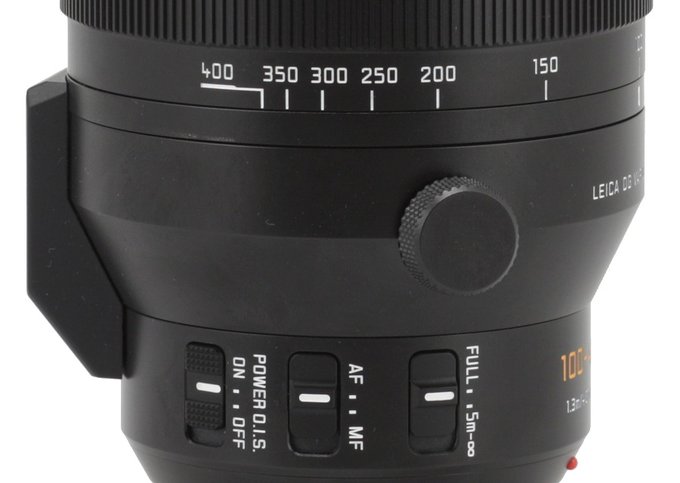 |
Then the ring increases its diameter, featuring an inscription LEICA DG VARIO-ELMAR; next to it there is a screw used to turn the whole ring with a low tripod foot attached to it. We liked that low adapter very much – it sticks out below the body of the camera anyway but it is solidly joined with the lens. It seems a well-thought-out and functional solution.
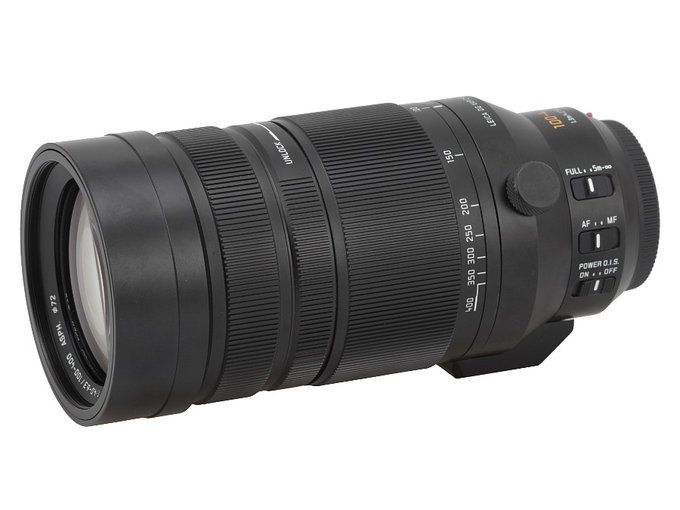 |
A zoom ring, as wide as 48 mm is the next part of the lens. Most of its surface is occupied by ribs and the trailing edge of this ring is stamped with focal length settings for 100, 150, 200, 250, 300, 350 and 400 mm. The ring turns with a bit uneven resistance, less pronounced in the 100-200 mm range and increasing as you get closer to the longer end of the focal range.
Further on you see an UNLOCK/LOCK ring which allows you to choose the resistance of the zoom ring and prevent creep; then there is a direct-drive manual focus ring, 25 mm wide and covered with ribs. It moves smoothly but with pronounced resistance; running through the whole scale needs a turn through an angle of about 360 degrees.
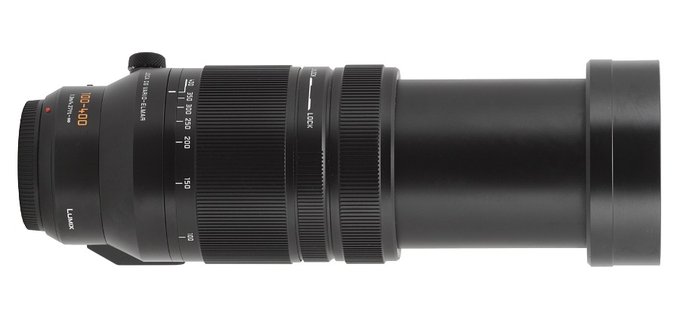 |
At the end of the lens there is another immobile ring made of metal with a short, slide out lens hood put on it.
The front element is 59 mm in diameter, surrounded with an inscription with the name and parameters of the lens and a non-rotating filter thread, 72 mm in diameter. As you increase the focal length the whole front element system extends on a uniform, plastic tube; as a result the size of the lens can increase by next 76 mm.
The optical construction of the Panasonic 100-400 mm consists of 20 elements positioned in 13 groups, including two ED (extra low dispersion) one UED (ultra low dispersion and one Aspherical ED element. Inside there is also a round aperture with nine blades which can be closed down to f/22 at the maximum.
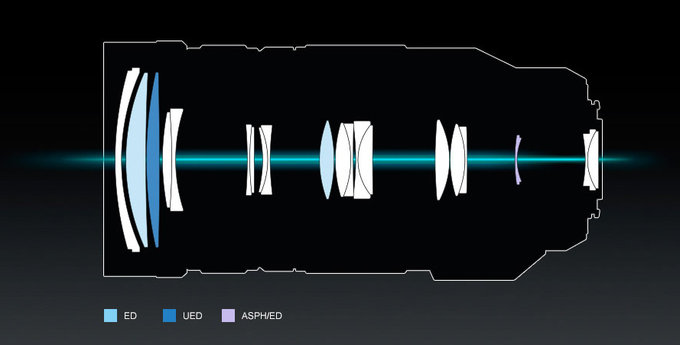 |
The Panasonic 100-400 mm should be also praised for a very rich accessory kit. Apart from two caps, front and end, a tripod foot and a slide out built-in hood you get also an additional extension for the hood and a spare tripod extension foot plus a soft carrying bag for the lens.
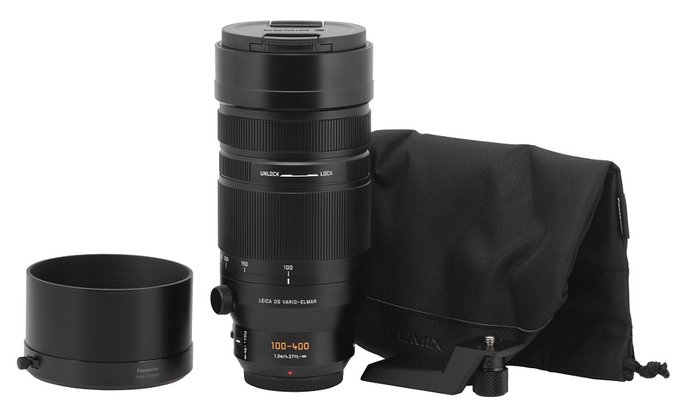 |
Optical stabilization
The optical stabilization test we conducted at the 400 mm focal length with the lens being attached to the Panasonic G7. We took several dozen photos with the stabilization switched on and off for exposure times ranging from 1/800 to 1/25 of a second; then we determined a percentage of blurry photos and presented it in a form of a time exposure function expressed in EV where 0 EV corresponds to 1/640 of a second.
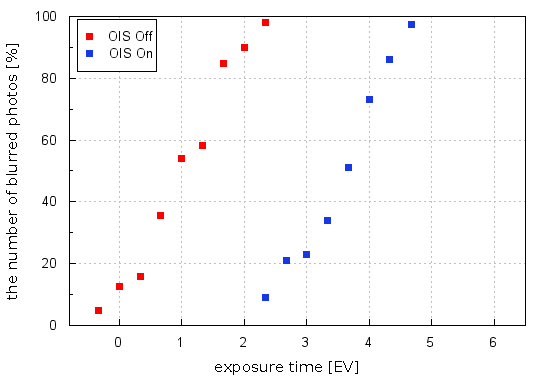
The maximum distance between both curves reaches 2.5 EV. It is not a result which might impress anyone nowadays. Good quality telephoto lenses can have stabilization units as efficient as 4-4.5 EV so the Panasonic lacks behind in this area. It’s a pity – we are sure that while shooting photos at the equivalent of the 800 mm focal length you will need help of very efficient stabilization.






